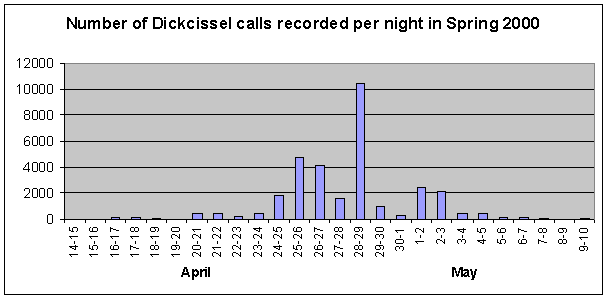
Dickcissel Night Flights | Home | Spring 2000 | Spring 2001 | Spring 2002 | Spring 2003 | Spring 2004 | Spring 2005

This graph shows the total number of confirmed Dickcissel flight calls recorded across the transect each night during the Spring 2000 monitoring. The data gives a rough indication of the timing of the Dickcissel flight across the Rio Grande Valley. On some nights not all recording stations operated so the night to night comparison needs some interpretation. In particular, the Mission High School station did not operate on the night of 27-28April and the neighboring McAllen High School station recorded over 500 calls that night. Because of the good correlation between these two stations during the season it is likely that Mission High would have detected hundreds of calls that night. This likely would have bumped the total on the night of 27-28 April above 2000 calls. It appears that the night of 27-28April still had lower overall calling than the previous and following nights. Also, the nights of 29-30April and 30-1May were missed at the Mission High, McAllen High, and Harlingen South High School recording stations. These were some of the most productive stations during the Spring 2000 season and, considering the number of calls detected at other stations on these two nights, it is very likely that an additional 2000 - 4000 calls would have been detected by these stations on these two nights.
Considering these latter corrections, it is readily apparent that the peak (90%) of the nocturnal Dickcissel migration (as determined by call notes) across the southern Rio Grande Valley occurred in a 10 day period from the night of 24-25April through the night of 2-3May. This corresponds with the timing of the Dickcissel flights recorded during previous spring migrations in the southern Rio Grande Valley since 1994. Over 30,000 Dickcissel calls were detected in the spring 2000 monitoring. If all stations had been in operation every evening it is estimated that about 35,000 calls may have been detected. It is not known how many birds this calling data represents.